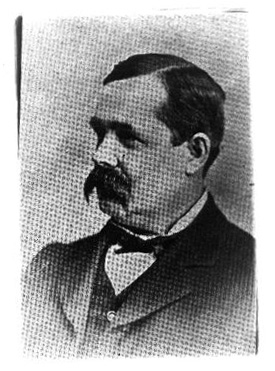BACKGROUND OF CLEMENT A. LOUNSBERRY
Late in the evening of July 5, 1876, the Missouri River steamer Far West pulled up to the dock at Bismarck, Dakota Territory. Soon its crew spread the news in the town that Lieutenant Colonel George Armstrong Custer and 268 men of his 7th U.S. Cavalry Regiment had been killed in battle with the Plains Indians on June 25-26, 1876, at the Little Bighorn River in Montana Territory. Editor Clement Lounsberry worked tirelessly throughout the night to produce a special edition of his newspaper, the Bismarck Tribune, published the next day, July 6, 1876, that carried the first full account of what would become known as one of this country’s most famous battles. In addition, he telegraphed the news to the New York Herald and other Eastern newspapers. Among the battle casualties at the Little Bighorn was Lounsberry’s reporter, Mark Kellogg.
Lounsberry began with little in life, but gained much success, first as a military officer during the Civil War and then as a frontier journalist from the late 1860s through the mid-1880s. However, for a 20-year period, beginning in the 1880s until about 1905, Lounsberry found long-term success difficult to maintain. He bounced from position to position until in 1905 he finally landed a political post as a clerk in the Central Land Office headquarters in Washington, D. C.
Born March 27, 1843, in DeKalb County, Indiana, Lounsberry was orphaned as a youth. At the outbreak of the Civil War, Lounsberry, a farm laborer in Michigan, enlisted as a private in Company I, First Michigan Volunteers. Wounded and taken prisoner July 21, 1861, at the First Battle of Bull Run, he spent a year in Confederate hands. Exchanged in June 1862, he received an officer’s commission and moved up the promotion ladder quickly. As a Colonel commanding two units, the First Michigan Sharpshooters and the Second Michigan Infantry regiments, he received the surrender of Petersburg, Virginia, on April 3, 1865.
Besides his wound at Bull Run, Lounsberry sustained three other war injuries. The last wound, at Spotsylvania, troubled him the rest of his life, a granddaughter, Mrs. Helen Hennessy of Highland, Illinois, said in a June, 1983, interview. “He limped,” said Mrs. Hennessy about her grandfather, whom she knew as a little girl in Duluth, Minnesota. “He always walked with a cane. In 1887, his leg had to be broken because it troubled him.” A biographical sketch about Lounsberry in the History of the Great Northwest and its Men of Progress corroborates her recollections. “The last wound has troubled the colonel through life, and in 1887 his leg was broken as a result of it.” Lounsberry’s handicap is critical in judging the authenticity of his claim that he intended to travel with Custer.
After the war, he moved to Martin County, Minnesota, where in 1868, he began publishing his first newspaper, the Martin County Atlas which he moved to Wells, Minn., in 1870. About that time, he apparently began contemplating a move farther west. Hyde and Stoddard report that “As early as 1870, he had arranged for the establishment of a newspaper at the crossing of the Missouri river by the Northern Pacific, when it should reach that point….”Lounsberry biographies report that by 1872 he had joined the Minneapolis Tribune as an editorial writer and legislative reporter. Even after he established his newspaper in Bismarck, he spent winters in Minneapolis, covering the legislature for its Tribune.
On July 11, 1873, the first copy of the Bismarck Tribune came off the press. According to several accounts, Mark Kellogg received the second copy. As Lounsberry termed him, Kellogg was an “attache of the Tribune in its early days.” Actually, research into Kellogg’s life reveals that he substituted for Lounsberry as editor of the Tribune’s second, third and fourth issues — July 16, 23 and 30, 1873 — during the first of Lounsberry’s many absences that first year. However, the paper’s chronic financial woes in those early years prevented Kellogg from holding a regular position with it.
Lounsberry, a staunch Republican, operated the Tribune for about 12 years (except for a year in the late 1870s). When he sold the paper in 1884 to Marshall Jewell, Lounsberry hoped to be appointed governor of Dakota Territory, but lost out to another newspaperman, Gilbert A. Pierce of the Chicago Daily News.
His next 20 years never matched his expectations. As time passed, perhaps out of these disappointments in his own career, he glorified his ties to Custer and the Little Big Horn. During this period, his two principal activities involved his appointment in 1889 as a special agent of the General Land Office and his operation in the 1890s of an historical monthly magazine at Fargo, he Record in the late 1890s.
He also was instrumental in organizing the North Dakota Historical Society in the 1890s, and his magazine enabled him to gather information about the state, which became the foundation for his later acclaimed book, North Dakota: History and People which first appeared in January 1917.
After Lounsberry moved to Washington, D. C., in 1905 to work in the General Land Office, he never again called North Dakota home. He died on Oct. 2, 1926, in Washington and was buried in Arlington National Cemetery.
COLONEL CLEMENT A. LOUNSBERRY
WASHINGTON, October 4, 1926 – Colonel Clement A. Lounsberry, aged 84, veteran of the Union Army during the Civil War and founded the Bismark, North Dakota Tribune fifty years ago, died here today.
Michael Robert Patterson was born in Arlington and is the son of a former officer of the US Army. So it was no wonder that sooner or later his interests drew him to American history and especially to American military history. Many of his articles can be found on renowned portals like the New York Times, Washingtonpost or Wikipedia.
Reviewed by: Michael Howard

